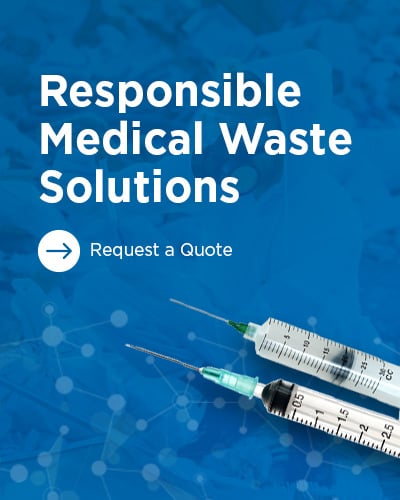
In previous articles we have identified the different types of medical waste produced in dental offices and some ways of lowering the costs for the disposal of that waste. This article will address hazardous waste specifically, and the regulations surrounding its disposal. Hazardous waste can be found in any physical state; liquid, gaseous, or solid. The type of disposal depends entirely upon the physical state the waste is in, and determines the need for further treatment. Today we will discuss:
- Types of medical waste
- Hazardous waste defined
- Disposal of hazardous waste

Types of Medical Waste
According to the World Health Organization, there are eight types of medical waste:
- Infectious waste: waste contaminated with blood and other bodily fluids (e.g. from discarded diagnostic samples), cultures and stocks of infectious agents from laboratory work (e.g. waste from autopsies and infected animals from laboratories), or waste from patients with infections (e.g. swabs, bandages and disposable medical devices);
- Pathological waste: human tissues, organs or fluids, body parts and contaminated animal carcasses;
- Sharps waste: syringes, needles, disposable scalpels and blades, etc.;
- Chemical waste: for example solvents and reagents used for laboratory preparations, disinfectants, sterilants and heavy metals contained in medical devices (e.g. mercury in broken thermometers) and batteries;
- Pharmaceutical waste: expired, unused and contaminated drugs and vaccines;
- Cytotoxic waste: waste containing substances with genotoxic properties (i.e. highly hazardous substances that are, mutagenic, teratogenic or carcinogenic), such as cytotoxic drugs used in cancer treatment and their metabolites;
- Radioactive waste: such as products contaminated by radionuclides including radioactive diagnostic material or radiotherapeutic materials; and
- Non-hazardous or general waste: waste that does not pose any particular biological, chemical, radioactive or physical hazard.
Hazardous waste makes up only 15% of all medical waste (1), yet it is accompanied by heavy regulations in regards to its disposal. Each state has clear definitions for what materials qualify as hazardous, so it’s vital to an organization to clearly understand the expectations put before them when it comes to properly disposing of medical waste.
Hazardous Waste Defined
Hazardous waste is defined as waste with “properties that make it dangerous, or capable of having a harmful effect on human health and the environment”. (2) In order to be classified as hazardous, the waste must exhibit one or more of the following traits: Ignitability, Reactivity, Corrosivity, or Toxicity.
- Ignitability: having the ability to set on fire; kindle.
- Reactivity: having the ability to act in response to an agent or influence.
- Corrosivity: having the quality of corroding or eating away; erosive.
- Toxicity: the quality, relative degree, or specific degree of being toxic or poisonous.
Disposal of Hazardous Waste
As stated previously, the type of disposal for hazardous waste depends entirely upon the physical state the waste is in, whether that be liquid, gaseous, or solid, and determines the need for further treatment. Sometimes that treatment leads to recycling of the hazardous waste, and sometimes that treatment is in preparation for the hazardous waste to be disposed of in a landfill. Pictured below is the EPA’s “cradle to grave” federal program of managing hazardous waste “meaning from the time it is created, while it is transported, treated, and stored, and until it is disposed”. (3)
Image source: https://www.epa.gov/hw/learn-basics-hazardous-waste#cradle
Creating a medical waste management plan that clearly states what items will be classified as “hazardous waste” is imperative to a facility’s proper disposal of waste. Once a facility’s staff has been made aware of what materials qualify as hazardous and a medical waste management plan has been created, an office has the option of utilizing a mail-back system for its medical waste. Small quantity generators of waste like dentist and small healthcare facilities can benefit by utilizing a mail back system. This reduces the cost for disposal significantly by eliminating long term contracts, monthly fees and fuel surcharges. To find solutions for mail-back waste disposal, click HERE.
Sources:
(1) “Health-Care Waste.” World Health Organization, World Health Organization, 8 Feb. 2018,www.who.int/news-room/fact-sheets/detail/health-care-waste.
(2) EPA, Environmental Protection Agency, https://ofmpub.epa.gov/sor_internet/registry/termreg/searchandretrieve/glossariesandkeywordlists/search.do?details=&glossaryName=Universal Waste Glossary.
(3) “Learn the Basics of Hazardous Waste.” EPA, Environmental Protection Agency, 16 Aug. 2017, www.epa.gov/hw/learn-basics-hazardous-waste#cradle.





